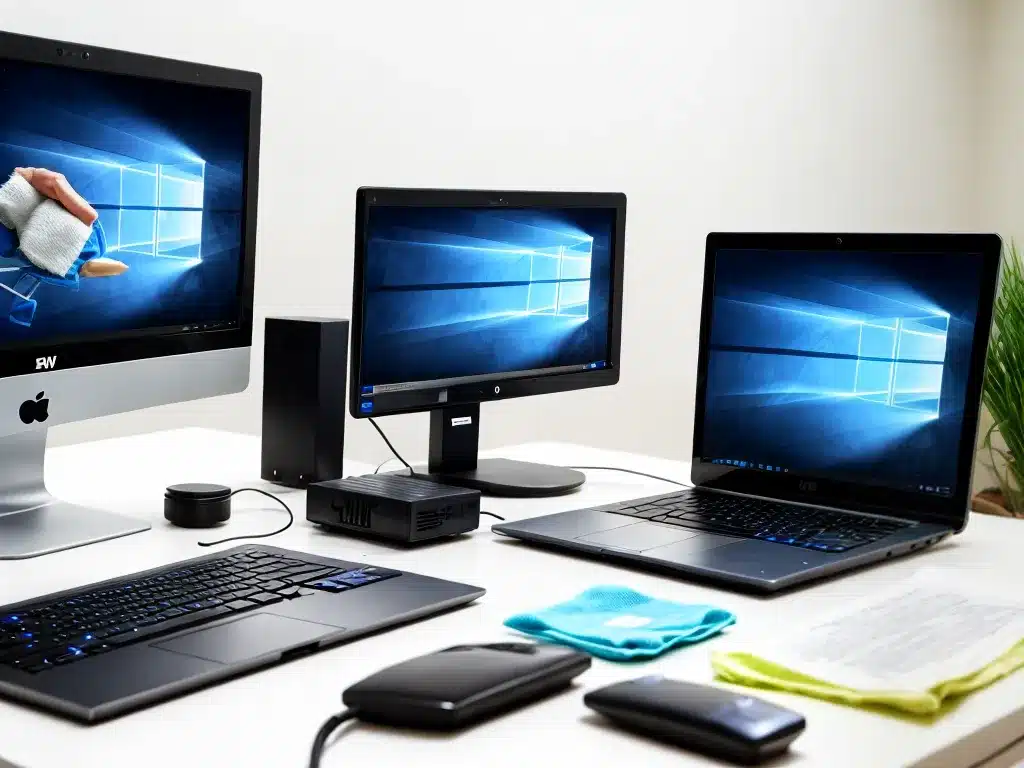
Introduction
Keeping the inside of your desktop PC clean is important to ensure it continues running smoothly and to prevent overheating. However, you need to be careful when cleaning the inside to avoid damaging sensitive components. In this comprehensive guide, I will walk you through the entire process of safely cleaning the inside of a desktop PC.
Gather the Right Cleaning Supplies
Before opening up your desktop, gather the proper cleaning supplies:
-
Compressed air can – This is essential for blowing dust out of hard to reach areas. Make sure the can has a straw attachment.
-
Microfiber cloth – Use a lint-free microfiber cloth designed for cleaning electronics. This will wipe down components.
-
Small paintbrush – A soft bristle paintbrush helps gently brush away dust in confined areas.
-
Isopropyl alcohol – High percentage isopropyl alcohol (90% or greater) combined with the microfiber cloth can remove dried on thermal paste or debris.
-
Cotton swabs – Cotton swabs are helpful for wiping in really tight spaces.
Avoid using water or liquids other than isopropyl alcohol, as you do not want to get moisture inside your desktop.
Power Down and Unplug the Desktop
Before opening up the desktop case, you need to power it down completely:
-
Click on the Start menu and select Shut Down.
-
Once the desktop has fully shut down, flip the switch on the power supply to the off position.
-
Unplug the power cable from the back of the desktop.
Powering down and unplugging prevents components from receiving power while you clean, avoiding any possibility of short circuits.
Open Up the Case
To access the inside of the desktop, you need to open the case. The procedure varies by case model, but there are typically screws on the back that need to be removed.
Consult your computer’s manual for exact instructions on removing the case panels. Often, the side panels slide off after removing screws.
Be very careful when removing panels so as not to damage any components or connectors.
Use Compressed Air to Remove Dust
Once inside, use short bursts of compressed air to blow dust off of components:
-
Hold cans upright – Tilting compressed air cans can cause liquid to spray out, possibly damaging components.
-
Use the straw attachment – The straw gives you precision aim for small spaces.
-
Focus on fans, vents, and heat sinks – These are common dust traps and important to keep clean.
Avoid blowing air directly at sensitive components like the CPU. Instead, blow dust away from the component.
Make sure to blow out dust that has collected at case vents and any dust filters.
Wipe Down Components
After using compressed air, some dust or debris may still be clinging to components. Gently wipe down components with a microfiber cloth.
-
Lightly dampen cloth with isopropyl alcohol as needed for dried-on debris. Be very careful not to use too much.
-
Gently wipe down the motherboard, RAM, graphics card, cables, etc. Wipe in one direction rather than wiping back and forth.
-
Pay special attention to the CPU and graphics card heat sinks. Carefully clean between fins while avoiding bending them.
-
Unplug any cables that are blocking access before wiping down components.
Check Thermal Paste on CPU and GPU
While inside your desktop, check the thermal paste on your CPU and GPU heat spreaders. Thermal paste helps transfer heat away from these chips.
-
Visually inspect paste. If it is dried out or mostly gone, new paste needs to be applied for optimal cooling.
-
To replace, clean off all old paste with isopropyl alcohol. Apply new paste in about a pea sized dot on the chip surface before reattaching the cooler.
Replacing aging thermal paste can significantly improve temperatures in an older desktop.
Use Paintbrush and Cotton Swabs for Tight Spaces
For very confined, hard to reach areas, use a small paintbrush and cotton swabs.
-
Gently use the paintbrush to dislodge dust around component edges and vents.
-
Lightly dampen a cotton swab with isopropyl alcohol to clean in narrow gaps between components or connectors.
-
Take your time and be very careful using any tools around delicate components.
Check All Connectors and Cables
Before putting the case back together, inspect all connectors and cables:
-
Ensure all cables are fully plugged in to components like the motherboard, graphics card, and drives. Reseat connectors if needed.
-
Check for any damaged cables, such as split wire insulation. Damaged cables should be replaced.
-
Organize and tie back cables to improve airflow using zip ties or velcro straps if they are loose.
Reassemble Computer and Power Up
After completely cleaning the inside, carefully put the case back together reversing the steps you took to open it up. Screw the case panels back on securely.
Plug the power cable back into the computer but leave the power supply switched off. Connect your display, mouse, and keyboard.
Turn on the power supply and press the computer’s power button to turn it back on. The desktop can then be used as normal.
Take your time and be very gentle when handling components to safely clean your desktop PC interior. Keeping the inside dust-free will extend its life!












